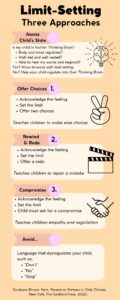Limit setting is a buzz word in many parenting books and in the play therapy world and rightfully so. Limit setting really is a valuable tool for parents and adults in a child's life promote healthy mental health in our children at every age of a child's development. Limits promote external safety, internal safety, emotional regulation, social skills, and healthy brain development, and lay the foundation for a nurturing and enjoyable parent-child relationship. Consistency is the backbone of limit-setting, particularly when both child and their parent(s) are experiencing strong emotions. Consistent language, expectations, and follow-through over time will help shift a child’s challenging behaviors. In order to provide consistency and healthy limit setting, parents (and all adults for that matter in a child's world) must first recognize and regulate their own internal state.
In finding ways to regulate our own emotions, we must first pause, label your emotions, take a breath, and support your body with one hand on your heart and one hand on your belly. Only engage with your child when you feel regulated and in your “thinking brain” rather than your “emotional brain”.
Next, evaluate whether your child is in her “thinking brain”. Some cues for considering if your child is in their thinking brain include considering the following questions:
Is she well-fed and well-rested?
Is she capable of hearing your words, offering a response, and making a choice?
If so, it is an appropriate time to set a limit. If your child is instead in her “emotional brain” - having meltdowns or tantrums, overly-tired, aggressive, or showing another cue of dysregulation - focus instead on helping her regulate the same way you did, by naming the feeling, breathing together, taking a walk, or offering another form of connection like supportive touch (a back rub, rocking her back and forth, offering a hug).
Setting Healthy Limits
Paris Goodyear-Brown, Licensed Clinical Social Worker, offers three frameworks to set a limit, depending on your parenting style, your child’s needs, and the specific circumstances. Each of the three frameworks begins with naming your child’s emotion, need, or desire. Empathize with your child, even if her reaction seems unreasonable to you. Children want to feel understood, and often escalate their behavior until they are fully seen and heard.
Naming and acknowledging your child's emotion, need, or desire may sound like:
- “I see you really want to finish your video game before dinner.”
- “You’re frustrated because you don’t want to wear this shirt to school today.”
- “You’re so excited to see grandpa that you almost ran across the street.”
After acknowledging how your child is feeling, set the limit
:- “It’s time to turn off the video game and eat dinner.”
- “We need to get dressed quickly for school.”
- “Running across the street is not safe.”
Once you've named their emotion and set the limit, you can consider one of the following frameworks to redirect your child.
Framework One : Offer Two Choices
Some Choice Examples:
- “You can turn off the video game by yourself, or I can help you.”
- “You can turn off the video game in two minutes or four minutes.”
- “You can choose a shirt or I can choose one for you.”
- “You can wear your Paw Patrol shirt or your Thomas shirt.”
- “You can hold my hand when we cross the street or you can wait until I tell you it’s safe to cross.”
*Offer just two choices; any more will overwhelm your child
Framework 2: Offer a Redo
Acknowledge that your child is still learning, and provide an opportunity to try again.
- “We’re still getting used to our dinner routine. Let’s rewind and try again. When I ask you turn off your video game, you’ll do it right away this time.”
- “I remembered that you’re still learning how to get dressed by yourself! Rewind! Show me how you can choose your own shirt.”
- “You’re learning how to cross the street like a big boy! Let’s go back to the house and walk together with slow feet.”
Framework 3: Offer a Compromise
Encourage your child to ask for a compromise. Only use this framework if you are truly willing to negotiate.
- “Try asking for a compromise…15 minutes more of video games is too long, and dinner will get cold. How about 8 minutes?”
- “Let’s figure this out together. How would you like to get dressed?.....That white shirt will get dirty during recess, but how about this other Lego shirt?”
- “Let’s negotiate!... Yes, you can run halfway through the yard, then stop at the tree and wait for me”
Finally, praise your child for making a choice, redoing the behavior, asking for a compromise, or accepting ‘no’.
Setting limits, like any skill, will take time, practice, and patience for both you and your child. We welcome you to refer to the infographic below, even print it out for easy reference on setting limits. Take care of yourself, show empathy, and demonstrate consistency!

References:
Goodyear-Brown, Paris. Parents as Partners in Child Therapy. New York, The Guildford Press, 2020.
Boston University Children’s Center. “Setting Limits.” April 2020. https://www.bu.edu/childrens-center/files/2020/07/Limit-Setting.pdf





